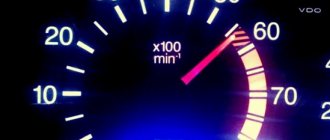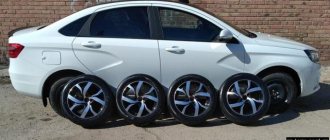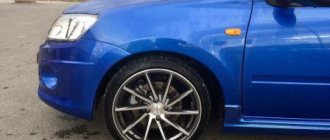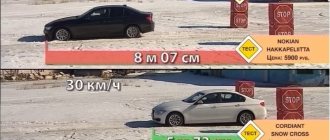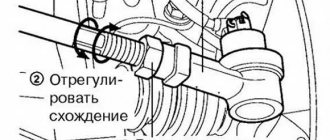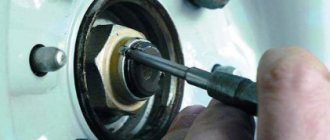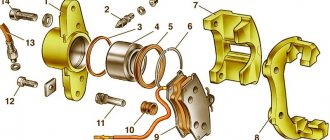Despite the huge selection of domestic and foreign cars, our car enthusiasts still give preference to the domestic automobile industry. They are no longer the most prestigious, but remain reliable “horses” for several generations.
What tire sizes does the VAZ 2110 manufacturer recommend installing?
The manufacturer gives specific recommendations on what tires should be installed.
The VAZ 2110 is a front-wheel drive car, and the manufacturer recommends installing tires: 175/70 R13, 175/65 R14. This is stated in the instruction manual.
What non-standard sizes can be supplied?
It is possible to install the following non-standard sizes on the VAZ 2110. Tires in sizes 185/60 R14, 195/50 R15, 195/45 R16.
Some manage to install 205/50 R15, but they have to modify the design with a “file” and there is no particular point in this - controllability is lost and the load on the engine increases. The only positive aspect is the appearance and that is a moot point.
For a better understanding, let’s decipher one of the tire types (195/65 R15 91T):
where 195 is the tire width in the tread area, mm;
65 – profile height, % of width (in this case 65% of 195);
R15 – landing diameter, inch (R – radial cord shape);
91 – load index, kg. Shows the maximum permissible load on one wheel. Mainly for passenger vehicles, it is done with a reserve and is not decisive when choosing tires (91 is up to 615 kg);
T – speed index. Driving speed limit. (T – 190 km/h).
Important! When installing new tires, it is imperative to balance the wheels.
Tire and wheel sizes for VAZ 2108, 2109, 21099, 2110, 2111, 2112 cars
| Disc diameter in inches | Wheel width in inches | Reach (ET), mm. | Tire size, mm/% |
| R13 | J5.0 | 35-38 | 155/75, 165/70 |
| J5.5 | 35-38 | 175/70, 185/65 | |
| R14 | J4.0 | 45 | 135/80 |
| J5.5 | 35-43 | 165/65, 175/65, 185/60 | |
| J6.0 | 35-40 | 175/65, 185/60 | |
| R15 | J6.0 | 30 | 185/55 |
| J6.5 | 30 | 195/55, 195/50 | |
| J6.5 | 35 | 195/50, 205/50 | |
| J7.0 | 35 | 195/50, 205/50 |
What is the tire pressure
The manufacturer indicates in the operating certificate the recommended tire pressure of 1.8 – 2.0 kgf/cm²
In general, tire pressure depends on the load, the weight of the car, and the air temperature; in addition, it needs to be checked periodically (once a week). If the ambient temperature has changed by at least 10 - 15 ° C, then you will have to check the tires again.
Practice shows that in winter it is necessary to make the pressure slightly lower than in summer for several reasons:
- slightly lowered tires make it easier to control the car on slippery roads;
- the suspension becomes softer, as a result of which uneven road surfaces are not felt so much;
- the braking distance is shorter, which significantly reduces the possibility of an accident.
In any case, each tire indicates the upper and lower pressure limits, beyond which it is extremely undesirable. But within the specified range you can experiment.
But don’t forget about the negative aspects of under-inflated tires:
- tread wear will accelerate;
- control will become more difficult (it will be harder to turn the steering wheel);
- fuel consumption increases noticeably;
- the effect of aquaplaning is enhanced;
- the overall towing capacity of the vehicle decreases.
If the tire pressure is exceeded:
- ride comfort will decrease due to the feeling of all the road irregularities;
- wear of the chassis accelerates;
- braking distance increases;
- possible uneven tread wear;
- if you hit a pothole or bump, the likelihood of a tire rupture increases;
- better car handling;
- traction force will increase;
- fuel consumption will decrease.
If the car is loaded to capacity, then the pressure is increased on the front axle to 2.0-2.1 kg/cm2, on the rear axle to 2.3-2.4 kg/cm2, and the spare wheel to 2.3 kg/cm2.
Car wheels
Produced since 1995, the car replaced the legendary “nines” and other models. It has gained great popularity in the vastness of not only Russia, but also many neighboring countries. At the moment it is no longer produced; it has been replaced by more modern models “Lada Vesta”, “Largus” and “Granta”.
Today, a very wide range of products for cars is presented on the shelves of auto stores.
This applies to both any exterior parts and VAZ wheels, which are produced in various ways and have all sorts of characteristics, sizes and parameters.
Owners of this domestic car, like any other, are always faced with the need to replace tires before a certain time of year. In this case, you have to choose from many options for products presented in stores. These can be either very well-known and expensive brands or cheaper models. The price category is also different: it depends on the quality, size and reputation of the manufacturer.
Important!
The choice of brand and characteristics of tires depends only on the personal preferences of the car owner.
It is important to remember that even products from very expensive manufacturers can be completely useless if used incorrectly. It is very important to select tires and wheels only with the correct sizes and constantly monitor their condition. This also applies to setting tire pressure, which is regulated by the manufacturer and must be indicated in the technical documentation.
It should also be noted that the safety of the driver and passengers will depend on the quality choice of tires.
In difficult weather conditions and on slippery surfaces, people’s lives often depend on the installed tires. In addition, tires have a huge impact on the level of wear of chassis parts, handling, dynamic characteristics and other qualities.
The tire size for the VAZ-2110, which is recommended by the factory, should also not be greatly exceeded, as this will affect comfort, increase wear on parts and increase fuel consumption.
You might be interested in this About winter tires on the Lada Vesta SV Cross
Tire size for VAZ 2110 R15
Review of the best summer and winter tires for the VAZ 2110
Every driver understands that the wheel plays a very important role not only in comfort and design, but also significantly affects driving safety. For this choice, the tire needs to be given enough attention. In addition to the basic or acceptable standard size, you should not forget about:
- speed limit in which the car will be operated (speed index);
- temperature regime (seasonality);
- climatic conditions (tread pattern and depth);
- weight load on wheels (load index).
If you choose tires by manufacturer, then from the many domestic ones you can choose several that have significantly increased the quality of their products compared to previous years. These can deservedly be called: Amtel, Matador-Omskshina, Kama.
- Amtel tires in Russia are undoubtedly the leaders (among domestic ones). Produced in Voronezh. In the process of testing this product, it was proven that it is no worse than foreign ones. The plant makes tires of all categories. The company has excellent specialists at its disposal who are constantly improving the production process.
- Matador-Omskshina is one of the youngest manufacturers, but sales volume is growing significantly every year. Drivers who prefer models from this manufacturer note reliability, stable performance and comparative cheapness.
- Kama (Nizhnekamsk) – produces tires for Russian buyers of all classes. But for cars of the 2110 model, the assortment is rather meager.
Advantages and disadvantages of stamped wheels for VAZ 2110
Initially, VAZ 2110 cars in the basic configuration are produced with stamped wheels. And many owners prefer not to change them due to a number of advantages that such discs have:
- high strength, which allows you to withstand aggressive driving style;
- high performance characteristics are designed for the condition of domestic roads;
- affordable price;
- ease of restoration of the stamped disk in case of damage.
Their main disadvantage is their outdated design, which spoils the look of the quite stylish and modern VAZ 2110 car. In addition, stamped wheels are heavy and susceptible to corrosion.
Summer tire
There are much fewer requirements for choosing summer tires compared to winter ones, but still a lot depends on the correct selection. For those who prefer domestic manufacturers - definitely Amtel, Matador-Omskshina or Kama (within 4000 - 4500 rubles you can completely “put on your shoes”)
If we consider summer tires of foreign brands, then these are NOKIAN. For example, NOKIAN - Nordman SX, when developing, the company’s specialists solved issues ranging from comfort to safety. Tests showed that the result was achieved. Excellent grip on the road surface (in any weather) is ensured by the original pattern. The special design of the tire, or rather the tread, will ensure a comfortable ride. Low-profile tires (195/50 R15 82H) from this manufacturer can be purchased for 2,800 rubles.
How to choose
For the highest quality and correct choice of tires for a VAZ-2110 car, it is important to know what the main differences are, as well as what types of tires there are.
According to seasonality, tires are divided into:
- All-season. The name universal is also common. They can be called a middle link between winter and summer tires. Manufacturers indicate that such tires can be used regardless of the time of year. However, leading experts recommend installing this type of tire only when the outside temperature is between -5 and +7 degrees Celsius. This temperature range is the one at which all-season products work most efficiently. In fact, universal tires are inferior to winter tires in the cold season, and summer tires in the warm season. Therefore, it is popular only in countries with a relatively warm climate and not very frosty winters. They must not be used in very hot or very cold weather conditions.
- Summer. Can only be used in a mode starting from a temperature of five degrees Celsius. The tread pattern of such tires is not very pronounced in comparison with their winter counterparts. By using summer tires at elevated temperatures, they become harder and are able to cool on their own. Suitable for traveling at high speeds and good road surfaces.
- Winter. Can only be used in winter with temperatures below zero degrees Celsius. The tread of such products is much deeper than that of summer ones. At cold temperatures, rubber is able to heat up on its own and increase its elasticity. Thanks to these factors, grip on the road surface increases. This gives the car greater controllability, reduces the braking distance and improves dynamic properties. The service life of winter tires usually exceeds that of summer tires because the average speed in winter is reduced and less wear occurs.
Note!
Universal tires can also be made specifically for use in countries with warm climates and rare temperature changes.
Such tires are not suitable for use in Russian winters, since the temperature at this time is much lower. When driving in Russia or neighboring countries, it is better to install tires designed for use in regions with moderate climatic conditions.
You may be interested in Belshina - tire review
An important criterion when choosing is the fact that tires for summer and winter have completely different chemical compositions, which are created for a specific season.
When the average outside temperature rises above +5 degrees, winter tires become very soft, wear out a lot and are not at all effective. Summer ones, on the contrary, harden very strongly at low temperatures.
It should also be noted that winter tires are distinguished by three types, which have different tread patterns:
- Designed for use in difficult winters. Some sources call them Scandinavian. Designed for use in very cold conditions with frequent precipitation in the form of rain and snow. Their tread has a pattern in the form of diamonds, which are staggered at a relatively large distance;
- Designed for use in mild winter conditions. There is another name - European. This type of tire can be used in various conditions. The tread has a "Christmas tree" pattern;
- Studded tires. They give the vehicle maximum efficiency during frequent use on ice and snow-covered road surfaces. They are distinguished by metal studs inserted into the tread, which ensure effective driving in icy conditions.
Winter tire
When choosing winter tires for a VAZ 2110, the contents of the driver’s wallet play an important role. After all, products on this market are represented by both domestic and imported manufacturers. But if rubber is expensive, this does not mean that it will be more efficient. It’s just that many imported manufacturers do not take into account the difference in climatic conditions and the concept of “winter” can be radically different. As a result, expensive tires in our regions can give poor results.
It is difficult to say about the advantages of certain winter tires - each person has his own opinion on this matter. Some prefer Nokan Hakkapeliitta (according to many, it is one of the best), while for others, the domestic Amtel is quite acceptable (the cost is of course lower, but the characteristics are quite acceptable).
The middle option would be models from manufacturers Hankook, Continental and Bridgestone, although domestic ones are still more profitable in terms of cost.
For example, Nokian Nordman RS2 185/65 R14 90R XL can be bought for 3700 – 4200 rubles. This winter tire has a low noise level and a long service life. Equipped with a tread wear indicator. The wedge-shaped laminated design ensures a stable ride. The degree of grip during braking is enhanced by the serrated sipes. Has a reinforced sidewall.
Amtel NordMaster ST-310 185/65 R14 86Q is a domestic tire that, according to car enthusiasts, deserves a solid 4. It runs well, the tread is deep. On snow it’s ok, but on ice it’s weak. The obvious disadvantage is increased noise. You can buy up to 1500 rubles. a piece.
What tire sizes does the manufacturer recommend to install?
The standard size depends on the body type. Moreover, all cars without exception used discs with a hub diameter of 58.5 mm. The amount of overhang could fluctuate - within 37-40 mm. The rim width is also typical - 5-5.5J. The most common model is 2110. This digital combination is used to mark a car with a sedan body.
The manufacturer recommends the following sizes:
- 2110, 21101, 21102 – 175/70 R13;
- 21103, 21104 – 175/65 R14.
"Razboltovka" - 4x98 mm. A special modification is the VAZ 21108 Premier car. The car was produced for a relatively short time - from 1999 to 2001. The only difference from previous versions is that alloy wheels with a diameter of 13 inches were installed at the factory. There are no fundamental differences for station wagon cars.
The issue was carried out between 1997 and 2004. The wheels installed at the factory differed depending on the modification of the car and the marking of the specific model:
- 2111 – 175/70 R15;
- 2111i-2114 – 175/65 R14.
Hatchbacks were produced, like most other cars in this series, until 2004. The diameter of the wheels and their dimensions also differed slightly depending on various factors:
- 2112 – 175/65 R14;
- 21122 – 175/70 R13;
- 21124 – 175/65 R14.
Using tires of standard size and diameter will avoid damage to the body and other troubles. However, the automaker suggests the possibility of installing custom-sized wheels.
What wheels were installed on different car bodies and configurations?
The factory equipment of the car is limited to the installation of stamped wheels. They have good performance in terms of strength, service life and wear resistance. However, as far as appearance is concerned, there is still room for work.
By the time the LADA 2110 was released, the automotive market was already filled with various alloy wheels of various sizes. The best option is to install alloy wheels, which are attractive and durable.
Before purchasing new disks, you must remember that not every disk may be suitable for a car. The product is selected based on the parameters determined by the vehicle manufacturer. The bolt pattern, the size of the central hole and the nuts that will secure the disk are taken into account.
And that's not all - the territorial conditions (climatic features) in which the car will be operated are also considered, as well as the external data of disks from various manufacturers.
The AvtoVAZ plant installed stamped wheels in black or white with the following standard parameters:
- bolt pattern 4x98, which indicates that the disk model is fastened with four studs, each 98 mm long
- departure ET35
The Ten is a universal model, the wheel arches of which allowed the installation of wheels with dimensions from R13 to R17. Car owners installed beautiful alloy wheels from well-known brands, which made the car even better.
How to choose the right alloy wheels
When choosing suitable rims for your car, you need to take into account certain dimensions:
- Diameter – R,
- Width – J,
- Departure: ET.
The mounting bolts are located along the diameter of the circle. The wheel size on the VAZ 2110 is 98 mm. The central hole should have a diameter of 58.5 millimeters.
When purchasing, you must also take into account the disc offset. Sometimes the length of conventional mounting bolts is short. During screwing, they only grip two or three turns of thread. This is not enough for a good fastening.
The problem can be solved very simply. You need to buy special extended bolts. They will securely fix the wheel.
Maximum and minimum possible parameters of non-standard disks
The most acceptable option for mounting on a VAZ 2110 is considered to be alloy wheels. When choosing alloy wheels, you need to consider the following parameters:
- R – disk diameter;
- J – rim width;
- ET – indicates departure;
- Dimensions of tires mounted on the rim;
- the diameter of the central hole is 58.5 mm;
- the diameter of the circle on which the bolts are fixed is 98 mm.
All these indicators may vary depending on the selected model. For example, for 13-inch wheels the width ranges from 5 to 5.5 with an offset of 35 - 35. On 14-inch wheels the width increases from 4 to 6, respectively, and the offset decreases from 45 to 35. For 15-inch models the values are different .
Compliance with these values is very important. Otherwise, you can get into a lot of trouble driving your car on the road. A car with small wheels still doesn’t look as stylish or presentable.
Tired of paying fines? There is an exit!
Forget about fines from cameras! An absolutely legal new product - Traffic Police Camera Jammer, hides your license plates from the cameras that are installed in all cities. More details at the link.
- Absolutely legal (Article 12.2);
- Hides from photo and video recording;
- Suitable for all cars;
- Works through the cigarette lighter connector;
- Does not cause interference to radios and cell phones.
Order with a discount
Selection of alloy wheels, non-standard tires, wheel bolts
Basic elements and dimensions of a passenger car wheel
| A – rim edge; B – shelf; B – ring protrusions (hamps) for additional fixation of the beads of a tubeless tire; G – wheel mounting plane; a – mounting diameter; | b – rim width; c – offset (distance between the plane of symmetry of the rim and the mounting plane of the wheel); d – diameter of the central hole; d – diameter of the circle where the mounting bolts are located. |
Many owners begin tuning their cars by installing new wheels and tires. It all depends on the purpose of tuning: those who want to compete off-road give preference to wheels with a reduced offset (these widen the track of the car) and tires with a deeply dissected, “toothy” tread pattern. But most try to give their cars a sporty look by installing beautiful alloy wheels (often with larger diameters and large rim widths) and matching wide, low-profile tires.
| Car models and modifications | Tire size, load capacity index, speed index | Wheels installed on a VAZ | Acceptable wheels | Number of mounting holes, diameter of their location, diameter of the central hole, mm | ||
| Size | Reach, mm | Rim width | Reach, mm | |||
| VAZ-2110, -21102, -2111 | 175/70R13 82 T, H | 5J-13H2 | 35 | 5J; 5.5J | 35 | 4x98x58.5 |
| 175/65R14 82 T, H | 5J-14H2 | 35 | 5.5J; 6J | 35 | 4x98x58.5 | |
| 185/60R14 82H | 5J-14H2 | 35 | 5.5J; 6J | 35 | 4x98x58.5 | |
| VAZ-21103, -2113, -2112 | 175/65R14 82 T, H | 5J-14H2 | 35 | 5.5J; 6J | 35 | 4x98x58.5 |
| 185/60R14 82H | 5J-14H2 | 35 | 5.5J; 6J | 35 | 4x98x58.5 | |
All fans of wheel tuning, without exception, should remember that not every wheel or tire, even those that fit your car in terms of seating and geometric dimensions, is officially approved for installation on it. The vehicle's Operation Manual clearly states the sizes of wheels and tires allowed for installation on vehicles of the “tenth” family.
The H2 index means the presence on the inside of the wheel rim of two humps - annular protrusions designed to securely fix the bead rings of a tubeless tire. The use of wheels of a suitable size, but having one hump or no humps, on cars of the “tenth” family is prohibited.
However, even within these “tolerances” it is possible to tune a car, and quite noticeably (which, in fact, is what is required from tuning). Wheels
| Steel wheel KFZ (Germany) |
| Steel wheel Mefro (Germany) |
It is believed that tuning a car with stamped steel wheels is not prestigious. However, they are also quite high-quality, and most importantly, they retain an attractive appearance for a long time, at a very reasonable price. Wheels suitable for “dozens” of sizes are produced by German companies KFZ and Mefro. You can also try on wheels designed for FIAT cars of the Uno, Tipo, Tempra, Punto, Bravo/Brava/Marea, Kroma models, since the VAZ “tens” are straight “ relatives" of the cars of the Italian concern.
Light alloy wheels are more popular for tuning. More often the alloy is based on aluminum, less often - magnesium (it is less resistant to corrosion, and in addition - more expensive). Wheels made of aluminum alloys, in turn, are divided into cast and forged. Cast wheels are made by machining castings. For forged wheels, the castings are pre-forged.
Alloy wheels have a number of noticeable advantages over stamped steel wheels. They are very attractive in appearance and varied in design, which allows you to choose the knitting needle pattern to suit your taste. Thanks to the lighter weight of the wheels (on average, they weigh 15-20% less than steel ones), the load on the components and parts of the car’s suspension is reduced, the operating conditions of the shock absorbers are made easier, and the tires experience less load when hitting road bumps. The car acquires better handling, becomes (albeit slightly ) more dynamic and economical, brakes better. As a rule, alloy wheels are manufactured with high quality, which means they have, on average, less imbalance compared to steel, which also has a beneficial effect on the service life of tires and suspension elements.
| Alloy wheel (Russia) |
However, light alloy wheels also have disadvantages.
So, with a strong impact, they collapse (split), and do not crush like steel ones, i.e. usually cannot be repaired or restored. This must be remembered - despite the fact that the force of an impact that can destroy an alloy wheel significantly exceeds the force that can deform a steel rim. Wheel markings (clockwise)
| stamp of the State Standard of the Russian Federation; manufacturer's trademark; reach, mm (35); month and year of manufacture (6/03 – June 2003) |
Disc 1 of an alloy wheel is much thicker than a steel one. Therefore, standard bolts for fastening light alloy wheels are not suitable - they are not long enough. Special bolts of increased length, if they are not sold complete with wheels, should be selected carefully: bolts that are too long can touch the stationary parts of the brake when the wheel rotates, and bolts that are too short may not be held firmly enough in the hub.
| Bolts for fastening steel wheels (left) are not suitable for fastening light alloy wheels (right). Dimension “A” must be equal to the thickness of the hub flange |
The disk is the central part of the wheel that carries the rim.
The disk has holes for bolts and a central hole. The wheel as a whole is often mistakenly called a disk. Alloy wheels are usually expensive and are often targets for theft. To prevent it, bolts with original heads (“secrets”) are used, the keys to which are supposed to be held only by the owner of the car. It should be remembered that if the key is lost or damaged, the wheel can only be removed by destroying it. A similar need may arise if the protective cap of the bolts or the screw (bolt) securing it “sticks” to the wheel disk.
If the outer decorative coating (usually a transparent varnish of a special composition) is damaged, the light alloy wheel loses its attractive appearance. Light-alloy wheels are especially susceptible to scratches and chips on their surfaces when de-icing agents and salt get into them when the car is used in winter. It is almost impossible to restore damaged coating.
The demand for alloy wheels is quite high, so fakes are often found. Uncertified wheels that have not passed proper tests and inspections may turn out to be dangerous (not strong enough) in operation, and their dimensions may not correspond to the parameters of the vehicle. Therefore, when buying a set of wheels in a store or on the market, you should carefully study their markings and ask the seller for a product certificate. It is not recommended to purchase the first products you come across, being seduced by their attractiveness and cheapness: this can be very expensive.
Tires
The main parameters of the tire are contained in its designation printed on the sidewall, for example: 175/65R14 82 T Steel Radial Tubeless.
Let's decipher this notation:
175 – conditional width of the tire profile in mm; 65 – ratio of the tire profile to its width in percent. If this designation is absent on the tire, the profile height is 80-82 percent - such tires are called full-profile. Tires with a profile height of 70 percent or less are called low profile; R – radial tire designation; 14 – tire diameter in inches; 82 – tire load capacity index. For installation on cars of the “tenth” family, tires with a value of this index of at least “82” are allowed, which corresponds to a load capacity of at least 475 kg; T – tire speed index. For installation on cars of the “tenth” family, tires with the speed index “T” (permissible maximum speed 190 km/h) or “H” (permissible maximum speed 210 km/h) are allowed; Steel Radial is a designation for a radial tire with a steel cord belt. Tubeless is a designation for a tubeless tire. Tires that do not have this designation are tube tires.
The width of the tire profile is related to the width of the wheel rim: the wider the tire, the wider the rim required to fit it.
Structural elements and main tire dimensions
| D – outer diameter; H – tire profile height; B – tire profile width; d – tire diameter; 1 – frame; | 2 – breaker; 3 – protector; 4 – sidewall; 5 – board; 6 – side ring; 7 – filling cord. |
In addition to matching the wheel size, the tire must also match the parameters (wheel niche dimensions) of the car.
Tires that have a high profile (full profile) or a large width can touch the stationary elements of the car at maximum suspension travel, as well as when turning the wheel. When tuning a car, it is important not only to choose tires that match the size of the alloy wheels. Equally important is the correct choice of tire for its purpose. Thus, sports tires are the most popular among tuning enthusiasts. They are characterized by rounded “shoulders” (transitions from the tread to the sidewalls), a directional tread pattern with wide drainage grooves and sipes, often arranged in a herringbone or butterfly pattern, and wide tread blocks of low height. Diagonal or tube construction, as well as a frame without a metal cord, are excluded from these tires. Sports tires help improve the car's rolling performance, increase its maximum speed, improve braking dynamics, and reduce overall driving noise and fuel consumption. In addition, they have a slight lateral slip when cornering and successfully resist hydroplaning when driving in the rain.
| Diagram of water drainage of a high-speed tire tread |
However, tires with a sporty tread pattern are completely “helpless” at the slightest contamination of the road surface, as well as off-road and in winter.
In addition, low profile tires are more easily damaged when hit by uneven roads or when hitting foreign objects. This leads not so much to punctures as to distortion of the frame. It should be remembered that tires that have been repaired after punctures should not be subjected to heavy loads: driving on bad roads and at high speeds. Cross-country ability devices
| a – snow chains; | b – “spider” |
If a car is tuned by an off-road enthusiast, it is usually equipped with tires with a high profile and a deeply dissected tread pattern, which have good grip on loose, wet, slippery surfaces and soils.
These tires are not afraid of muddy field roads after rains and snow drifts in winter. However, it would be useful to remind the most desperate “crooks” of one well-known rule: the more cross-country ability a car has, the more difficult it is to rescue it if it does get stuck. Therefore, in addition to a strong tow rope, a shovel and various devices for increasing cross-country ability, available on sale, should take their place in the trunk: snow chains, spiders, rubber ramps, etc. With tires for winter and off-road, as a rule, it is uncomfortable on the asphalt. Due to the high tread blocks, they have significant lateral slip, create a lot of noise or hum when driving, and due to high rolling resistance they contribute to increased fuel consumption. And if the tire is equipped with anti-skid studs, its disadvantages include a slight increase in the braking distance of the car on dry (in winter - on frozen but clean) asphalt.
| Consequences of summer use of a studded winter tire: the tread blocks are damaged, the studs are on the verge of falling out |
Some drivers make a compromise by installing winter tires only on the front axle of the car, and non-season tires on the rear axle.
The traffic rules do not prohibit this (remember that it is unacceptable to install tires of different designs and with different tread patterns on one axle). But in this case, you need to load two spare wheels into the car at once instead of one: one with a winter tire, the other with a summer tire. Otherwise, a contradiction with the Rules will inevitably arise, and such a clause appeared in them, obviously, not by accident. An experiment conducted by testers from the magazine “Behind the Wheel” showed that when tires with different tread patterns are installed on the same axle, the car’s behavior deteriorates sharply, especially when braking (sudden, sometimes unpredictable drifts and turns are possible). Let us add that installing seasonal tires only on the drive axle of the car, of course, somewhat improves its behavior (for example, when installing winter tires - on slippery roads). But the car certainly doesn’t become “winter” at all. And in the summer, winter tires, even on a non-driving axle, will wear out quite intensively from contact with dry asphalt and from high speeds for which they are not intended.
